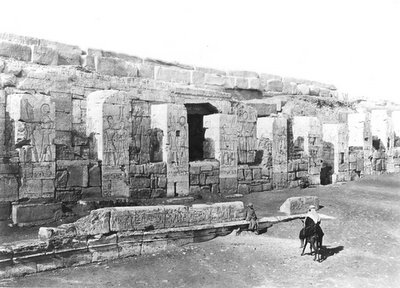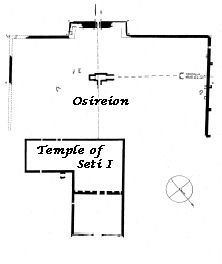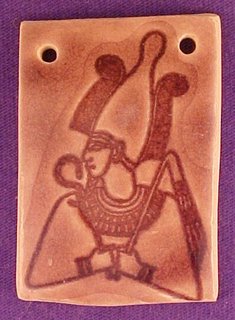The Mysterious Osirion at Abydos
Abydos (the Egyptians call it Umm el-Qa'ab) was the capital of early Dynastic Egypt, before the center of government was moved north to Memphis. This remote site, seldom visited by tourists, is the location of perhaps the finest New Kingdom temple, built during the rule of Seti I (Sety I), the first important pharaoh of the Nineteenth Dynasty. In 1902, behind that temple, William Flinders Petrie and Margaret Alice Murray discovered the Osirion (Osiron or Osireion).

The Entrance to the Temple of Seti I, from the outer courtyard.
While every New Kingdom temple in Egypt is different, adapted to the attributes of the god (neter) that it serves, they also have many characteristics in common. For example, all are built at ground level from stones of one or two tons weight and all have nearly every available space carved and painted. The Osirion breaks those rules. The floor is located 40 feet below the present ground level, the stones used in its construction often weigh 60 tons, and most of the walls are not decorated.
Abydos is the cult center of Osiris, the god of death and rebirth and there is little doubt that this strange structure is dedicated to him. But when was it built? The conventional explanation is that it was Seti I or his grandson Merenptah who caused it's construction, but advocates of an earlier, lost, pre-dynastic civilization in Egypt have noticed that the Osirion resembles only two known buildings - the two temples beside the Sphinx.
These two, called today the Sphinx temple and the Valley temple, are known to have been built from the stone removed from the base of the Sphinx during its' construction. This would place them, by conventional dating, in the Fourth Dynasty, about 4,500 years ago and over a thousand years before Seti.
Geologist Robert Schoch has examined the erosion of the Sphinx and the nearby temples and concluded that they were subject to heavy rain, a condition that ended in that region about 8000 years ago. His conclusion, to which other geologists concur, is a central piece of evidence in the argument for an earlier, so far undiscovered, civilization on the Nile.
So, how old is the Osirion? I recently examined the report of Mr. Petrie and Miss Murray who excavated the site in 1902-3.
"The cartouche of Merenptah appeared in every place where it could be inserted" says Miss Murray. Egyptian Research Account: 1903 While this could mean merely that Merenptah repaired an existing building, it should not be dismissed lightly. The temple of Seti is "L" shaped, the Osirion located beyond the central chapels. Thus the support areas are located on the side, rather than behind the central chapel, as they are in other temples. This conveys the idea that either the Osirion was considered more important than the chapels (Egyptian temples are arranged in a progression from the common to the most holy), or that it was pre-existing and Seti built his temple carefully in line with it. Thus the Seti Temple and the Osirion form a architectural whole. But Merenptah began his rule 34 years after Seti I's death.

The floor plan of the Temple of Seti I
and the portion of the Osirion discovered in the 1903-4 excavation season.
The entire Osirion is nearly as wide as the main section of Seti's temple
and includes most of the area between the portion shown and the temple.
Map drawn by Margaret Alice Murray
The Osirion is the only temple known from Ancient Egypt to be built below ground level. This has been presented as evidence that it is much more ancient than the adjacent Temple of Seti I, the slow deposition of silt raising the ground level over time. On this point Miss Murray will disagree:
"The nature of the desert is that after removing from two to four feet of loose wind blown sand, the hard marl, called gebel by the workmen, comes into view. This is so firmly compacted together that it can be cut like rock. The ancient builders took advantage of this fact, and excavated passages and halls with steeply sloping, almost perpendicular, sides. These were lined and roofed with great blocks of stone, and the hollow at the top filled up with sand; the building was then completely hidden from the outside. In our clearance it was only necessary to descend a few feet till the rock-like gebel was exposed, and then to follow down the excavation; and the trial pits that we sunk within the temenos invariably showed that the gebel had been cut perpendicularly to admit of building below." ibid
To recount Miss Murray: The desert in the area consists of loose sand to a depth of a few feet. Below that is gebel, basically rock. This rock was cut out to allow the building of the Osirion. Deposits of sand that contained Roman rubbish were not at all solidified.
 What secret ceremonies took place in these strange underground chambers? Osiris was the god of rebirth - perhaps the fertility ceremony each spring was centered here. Like a Native American Kiva, a dark underground space can make spirit more powerful.
What secret ceremonies took place in these strange underground chambers? Osiris was the god of rebirth - perhaps the fertility ceremony each spring was centered here. Like a Native American Kiva, a dark underground space can make spirit more powerful.
Could it have been an ancient, lost, civilization that cut away the rock and built the Osirion? Yes, it could have been, but there is nothing here to make that point, beyond the uniqueness of the design and the size of the stones. And it should be remembered that Sir Petrie, unlike modern archaeologists, was quite willing to accept the existence of an earlier, yet undiscovered civilization in Egypt.
Osiris was believed to have been a king in pre-historic, legendary times. Egyptian tombs were built underground - could this be his? Or is the nature of this site so removed from our way of thinking that we cannot comprehend its' purpose?
The report of Mr. Petrie and Miss Murray can be seen at:
AscendingPassage.com/Osirion-at-Abydos.htm
An overview of alternative theories of Ancient Egypt is :
AscendingPassage.com
There are many mysteries and secrets that hint of earlier, lost, civilizations:
AncientMystery.info
Great jewelry of Tibet and Nepal:
Tibetan-Jewelry.net

While every New Kingdom temple in Egypt is different, adapted to the attributes of the god (neter) that it serves, they also have many characteristics in common. For example, all are built at ground level from stones of one or two tons weight and all have nearly every available space carved and painted. The Osirion breaks those rules. The floor is located 40 feet below the present ground level, the stones used in its construction often weigh 60 tons, and most of the walls are not decorated.
Abydos is the cult center of Osiris, the god of death and rebirth and there is little doubt that this strange structure is dedicated to him. But when was it built? The conventional explanation is that it was Seti I or his grandson Merenptah who caused it's construction, but advocates of an earlier, lost, pre-dynastic civilization in Egypt have noticed that the Osirion resembles only two known buildings - the two temples beside the Sphinx.
These two, called today the Sphinx temple and the Valley temple, are known to have been built from the stone removed from the base of the Sphinx during its' construction. This would place them, by conventional dating, in the Fourth Dynasty, about 4,500 years ago and over a thousand years before Seti.
Geologist Robert Schoch has examined the erosion of the Sphinx and the nearby temples and concluded that they were subject to heavy rain, a condition that ended in that region about 8000 years ago. His conclusion, to which other geologists concur, is a central piece of evidence in the argument for an earlier, so far undiscovered, civilization on the Nile.
So, how old is the Osirion? I recently examined the report of Mr. Petrie and Miss Murray who excavated the site in 1902-3.
"The cartouche of Merenptah appeared in every place where it could be inserted" says Miss Murray. Egyptian Research Account: 1903 While this could mean merely that Merenptah repaired an existing building, it should not be dismissed lightly. The temple of Seti is "L" shaped, the Osirion located beyond the central chapels. Thus the support areas are located on the side, rather than behind the central chapel, as they are in other temples. This conveys the idea that either the Osirion was considered more important than the chapels (Egyptian temples are arranged in a progression from the common to the most holy), or that it was pre-existing and Seti built his temple carefully in line with it. Thus the Seti Temple and the Osirion form a architectural whole. But Merenptah began his rule 34 years after Seti I's death.

and the portion of the Osirion discovered in the 1903-4 excavation season.
The entire Osirion is nearly as wide as the main section of Seti's temple
and includes most of the area between the portion shown and the temple.
Map drawn by Margaret Alice Murray
The Osirion is the only temple known from Ancient Egypt to be built below ground level. This has been presented as evidence that it is much more ancient than the adjacent Temple of Seti I, the slow deposition of silt raising the ground level over time. On this point Miss Murray will disagree:
"The nature of the desert is that after removing from two to four feet of loose wind blown sand, the hard marl, called gebel by the workmen, comes into view. This is so firmly compacted together that it can be cut like rock. The ancient builders took advantage of this fact, and excavated passages and halls with steeply sloping, almost perpendicular, sides. These were lined and roofed with great blocks of stone, and the hollow at the top filled up with sand; the building was then completely hidden from the outside. In our clearance it was only necessary to descend a few feet till the rock-like gebel was exposed, and then to follow down the excavation; and the trial pits that we sunk within the temenos invariably showed that the gebel had been cut perpendicularly to admit of building below." ibid
To recount Miss Murray: The desert in the area consists of loose sand to a depth of a few feet. Below that is gebel, basically rock. This rock was cut out to allow the building of the Osirion. Deposits of sand that contained Roman rubbish were not at all solidified.
 What secret ceremonies took place in these strange underground chambers? Osiris was the god of rebirth - perhaps the fertility ceremony each spring was centered here. Like a Native American Kiva, a dark underground space can make spirit more powerful.
What secret ceremonies took place in these strange underground chambers? Osiris was the god of rebirth - perhaps the fertility ceremony each spring was centered here. Like a Native American Kiva, a dark underground space can make spirit more powerful.Could it have been an ancient, lost, civilization that cut away the rock and built the Osirion? Yes, it could have been, but there is nothing here to make that point, beyond the uniqueness of the design and the size of the stones. And it should be remembered that Sir Petrie, unlike modern archaeologists, was quite willing to accept the existence of an earlier, yet undiscovered civilization in Egypt.
Osiris was believed to have been a king in pre-historic, legendary times. Egyptian tombs were built underground - could this be his? Or is the nature of this site so removed from our way of thinking that we cannot comprehend its' purpose?
The report of Mr. Petrie and Miss Murray can be seen at:
AscendingPassage.com/Osirion-at-Abydos.htm
An overview of alternative theories of Ancient Egypt is :
AscendingPassage.com
There are many mysteries and secrets that hint of earlier, lost, civilizations:
AncientMystery.info
Great jewelry of Tibet and Nepal:
Tibetan-Jewelry.net
Labels: Ancient Mysteries, Archaeology, Egyptian Mysteries, Osirion at Abydos
